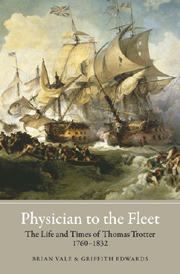2 - Medicine at Sea
from Background
Published online by Cambridge University Press: 12 September 2012
Summary
FOLLOWING IN THE FOOTSTEPS of other aspirants to the navy's medical service, in the winter of 1778 Thomas Trotter visited London to pass the necessary examination and secure an appointment. The first reaction of visitors to the metropolis was often one of amazement. Even to people like Trotter who were used to Edinburgh, the size and scale of London must have been bewildering. Peter Cullen, a compatriot who was visiting for the first time and for the same purpose, described himself as being ‘struck with astonishment … quite giddy with the noise, confusion, strange sights of wonderful and rare objects … for everything was new, strange and surprising’. With a population of over three-quarters of a million, London had long since outgrown its mediaeval boundaries and now stretched from Islington in the north to Lambeth in the south, and along the river from Westminster in the west to Limehouse and Rotherhithe in the east. It was still essentially the London of Dr Johnson, a vibrant mixture of industry and dissipation, riches and poverty, elegance and squalor, vanity and vice. At one extreme were the new squares of Mayfair and Marylebone with their genteel mansions, bow-fronted shops and fashionable coffee houses; at the other, the jumble of apartment houses, workshops, breweries, tanneries and taverns of Whitechapel and Wapping. Between the two, stretching from the white dome of St Paul's as far as London Bridge and Smithfield, lay the commercial heart of the city.
- Type
- Chapter
- Information
- Physician to the FleetThe Life and Times of Thomas Trotter, 1760–1832, pp. 19 - 34Publisher: Boydell & BrewerPrint publication year: 2011



